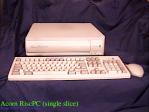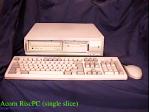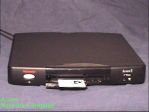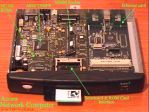This list represents some several days of work in researching and obtaining
all the data contained within. No guarantees are made to it's accuracy but all
efforts have been made to be as factual as possible. Many thanks go to all the
people who have contributed towards this list, without their help this list
would substantially shorter. This list has been frozen as of the 23rd of
Novemeber 1998, Acorn recently closed their workstation division and seem
unlikely to ever be making further desktop machines. Although I will be
tweaking the list to correct existing entries and to add any machines missed
up to the time at which the list was frozen.
Finally this list is copyright 1992-1999 to Philip R. Banks but may be
freely copied and distributed as long as it is distributed without
modification or change. It may be used in other publications/documents as
long as credit is given in the article to Philip R. Banks for the use of the
list.
There is a diverse range of Acorn machines basically classifiable into two
ranges. Older 8 bit machines and the newer 32 bit machines. Each entry in the
list is organised, after the textual blurb, in terms of :-
Default memory.
Default filing system(s).
Default processor.
Default RAM speed.
Size of OS when first released.
Approxiamate performance in MIPS.
For a series of models all models are listed in succession after the
textual blurb with the first line indicating the model number. Please note all
MIPS speeds are estimates, are in terms of the processor's speeds and are
not converted to Vax MIPS.
- Acorn System 1 - the earliest of the Acorn
machines. Powered by a 6502 CPU it had a staggering 256 bytes of static RAM
memory and a 512 byte monitor program. It was built from two sandwiched
eurocards, one for the CPU and the other a kepad and display. Described as
a `pig to use` it marked the begining of Acorns long association with the
6502 chip. It was released as a DIY kit. Released in 1979.
256 bytes Memory
Cassette interface.
6502 processor
1 MHz RAM.
512 bytes Monitor in ROM.
~0.2 MIPS.
- Acorn System 2,3 & 4 - A eurocard rack
system with a combination of cards including 6502 cpu, 6809 cpu, 32k static
RAM, 32k battery backed CMOS RAM, disc interface, versitile interface
adaptor, lab interface, econet, analogue interface, VDU interface and a
6502 ICE (In Circuit Emulation I am told). Functionally it was a System 1
CPU card with extensions.
32k Memory.
Disc interface.
Variable Processor.
1 MHz RAM.
~0.2 MIPS.
- Acorn System 5 - similar to the Systems
2,3 & 4 except that it had a 2 MHz 6502 and was the first Acorn machine to
be supplied with DRAM rather than static RAM.
32k Memory.
Disc interface.
6502 Processor.
2 MHz RAM.
~0.4 MIPS.
- Acorn Atom - this was powered by a 6502 chip
and had, by default, 2k of memory with total expansion limited at 12k. A
bit of a rarity these days to see a working model it had an integer only
BASIC supplied in ROM as well as the OS. Via an extension ROM floating
point operations could be added to the BASIC. Econet became available for
the machine in late 1980 and a floppy drive plus DFS could be added via an
expansion port. Finally the Atom was available in DIY kit form if you were
disposed to assembling your own machine. Released early 1980.
2k Memory. (Expandable to 12k)
Cassette interface.
6502 processor.
2 MHz RAM.
8k OS in ROM.
~0.4 MIPS.
- Acorn Proton - prototype version of the BBC
Model A. It was never released commercially under the Proton name and all
prototypes became BBC prototypes when the BBC contract was won. This is
given a seperate entry from the Model A more for historical reasons as the
Proton name is mentioned from time to time in Acorn lore.
16k Memory
Tape filing system by default.
6502 processor. (2 MHz)
4 MHz RAM.
16k of OS in ROM.
~0.4 MIPS.
- BBC Model A - cut down version of the
very popular BBC Model B. Powered by a 6502 chip it featured 16k of memory.
Released November 1981.
16k Memory
Tape filing system by default.
6502 processor. (2 MHz)
4 MHz RAM.
16k of OS in ROM.
~0.4 MIPS.
-
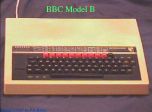
BBC Model B - the `full` version of the
Model A this machine became one of the most popular eight bit machines in
Britain. It also ran on a 6502 chip and had 32k of memory along with a
facility to easily include anywhere from 4-16 `sideways` ROM expansions. By
default the machine was only capable of taking 4 ROMs with two slots taken
by BBC BASIC (either versions I or II) and the other usually taken up by a
Disc Filing System. (The machine was released without the DFS to begin
with.)
Released November 1981 - early 1982. It appears that there was also
released an American/Canadian version of the Model B that had several
differences - namely that econet and speech systems were built in and that
the machine was set up for American monitors by default requiring a *UK to
enable it to run most software.
32k Memory
Tape filing system by default.
6502 processor.
2 MHz RAM.
16k of OS in ROM.
~0.4 MIPS.
- BBC Model B+ - this machine was a
stop gap addition to the BBC range of machines intended to keep the BBC
range viable while the Master was being developed. It came in two models,
the default model was equiped with 64k of memory and a D.F.S. by default.
(Unlike the Model B) It was the first of the Acorn machines to come with a
double density disc system as default. It had alot of the annoying
`glitches` of the model B cured and was also powered by a 6502 chip.
Released early 1984 it was quickly superceded by the Master range of
machines and Acorn drew loud criticisim for releasing the machines so close
together.
64k Memory
Double Density Filing system by default. (included tape as well)
6502 processor. (2 MHz)
4 MHz RAM.
16k of OS in ROM.
~0.4 MIPS.
- Reuters board - Effectivley a BBC Model B+ on a big eurocard for
rack mounting.
64k Memory
Unknown
6502 processor. (2 MHz)
4 MHz RAM.
16k of OS in ROM.
~0.4 MIPS.
- Acorn Business Computer - Acorns first attempt
at entering the business market and it was not a great success. It
consisted of a BBC Model B+ with a variety of second processors all
packaged in a new case with an integral monitor and seperate keyboard.
Second processors included a 32016 running Panos, 80186 running DOS & a Z80
running CPM. These machines were and are very rare, indeed I have yet to
hear from someone who has actually used one of these machines.
They consisted of eight models and were released late 1984.
Acorn Business Computer Model PA (Personal Assistant)
64k Memory
Disc Filing System by default.
6502 processor. (2 MHz)
4 MHz RAM.
32k of OS in ROM with ViewSheet.
~0.4 MIPS.
Acorn Business Computer Model Terminal.
64k Memory
No filing system by default.
6502 processor. (2 MHz)
4 MHz RAM.
32k of OS in ROM with a VT100 emulator in ROM.
~0.4 MIPS.
Acorn Business Computer Model 100.
64k Memory
Disc Filing system by default.
Z80 processor. (6502 processor acting as host for parasite Z80)
Unknown
32k of OS in ROM. Largely unused being replaced with CP\M.
~0.4 MIPS.
Acorn Business Computer Model 110.
64k Memory
Disc Filing system by default. (10 Megabyte hard drive)
Z80 processor. (6502 processor acting as host for parasite Z80)
Unknown
32k of OS in ROM. Largely unused being replaced with CP\M.
~0.4 MIPS.
Acorn Business Computer Model 200.
512k Memory (Unknown exactly)
Disc Filing system by default.
32016 processor. (6502 processor acting as host for parasite 32016)
10 MHz and 8 MHz RAM versions made.
32k of OS in ROM. Largely unused being replaced with Xenix.
~0.4 MIPS.
Acorn Business Computer Model 210. (Later known as the Cambridge Workstation)
4096k Memory
Disc Filing system by default. (10 Megabyte Hard Drive)
32016 processor. (6502 processor acting as host for parasite 32016)
6 MHz RAM.
32k of OS in ROM which was a boot loader for PANOS. Largely unused being replaced with Xenix.
~0.4 MIPS.
Acorn Business Computer Model 300.
1024k Memory
Disc Filing system by default.
80286 processor. (6502 processor acting as host for parasite 80286)
Unknown.
32k of OS in ROM. Largely unused being replaced with CP/M,MS-DOS or PC-DOS.
~0.4 MIPS.
Acorn Business Computer Model 310.
1024k Memory
Disc Filing system by default. (10 Megabyte Hard Drive)
80286 processor. (6502 processor acting as host for parasite 80286)
Unknown.
32k of OS in ROM. Largely unused being replaced with CP/M,MS-DOS or PC-DOS.
~0.4 MIPS.
-

Acorn Electron - this was Acorns `cut down` BBC Model B machine.
Designed to be a cheap alternative to the model B it had alot of design
trade offs in order to keep it cheap. A feature of it was its series of
expansion options that offered people the ability to upgrade it to almost
the same specs as a Model B. It was slower than the Model B even though it
was clocked at the same speed due to the fact that its screen refresh
demands were not done asycronously to the CPU resulting in cycle stealing
from the CPU especially in the higher resolution screen modes. That and the
memory was arranged in such a way that two accesses were required to
retreive a byte. It didn't enjoy a good history with supply problems
meaning that stock wasn't available in appreciable quantities till after
Christmas 1983 causing the machine to miss it's biggest opportunity for
sales. Launched August 1983.
32k Memory
Tape filing system by default.
6502 processor.
2 MHz RAM.
16k of OS in ROM.
~0.2 MIPS.
- British Telecom M2105 - An Electron with an
expansion box containg a speech synthesier and modem. Designed as a `smart`
comms terminal.
32k Memory
Tape filing system by default.
6502 processor.
2 MHz RAM.
16k of OS in ROM.
~0.2 MIPS.
- Communicator - A comms machine based
on a 65816 processor with an on board modem, comms software and featured
32k of CMOS RAM.
512k (32k battery backed CMOS ram extra) Memory. (Expandable to 1024k)
CMOS RAM and NET filing systems by default.
65816 processor.
2 MHz RAM.
256k of OS and bundled software in ROM.
Unknown.
- Briefcase Communicator -
Basically the same hardware as the communicator repackaged in a briefcase
with an added ramcard interface. See Acorn
Communicator - hardware functionally identical.
-
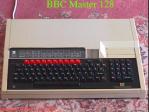
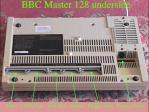
BBC Master range - this was the successor to the Model B range and
came out as three close but different machines. Powered by a 65C02 chip it
had extra instructions making some operations slightly faster and had alot
of software improvements as well as hardware improvements that made it a
large step foward. It came by default with a new and greatly improved Disc
Filing System called ADFS (Advanced Disc Filing System) as well as 128k of
memory as standard.
Released late January 1986 for the Master 128 and September 1986 Master
Compact.
128k Memory
ADFS filing system by default. (Also came with DFS and tape)
65C02 processor. (2 MHz)
4 MHz RAM.
16k of OS in ROM. (bundled with 48k more other ROM material)
~0.4 MIPS.
- BBC Master Turbo and Master 512 -
these were Master 128s with internal second processors and sold as a
complete package. Consequently the listing here only details the
capabilities of the second processor. Their external appearance is identical
to that of a Master 128.
Master Turbo
64k Memory.
65C02 processor. (4 MHz)
4 MHz RAM.
Minimal OS softloaded from the host computer.
~0.8 MIPS.
Master 512
512k Memory.
80186 processor. (8 MHz)
8 MHz RAM.
DOS softloaded from disc.
Unknown
- Acorn M19 - Re-badged Olivetti M19 PC-clone.
Based on an 8088 processor it also came with it's own monitor. (Indeed
that's what powered it...)
256k Memory.
DOS filing system.
8088 processor.
Unknown.
Unknown.
Unknown.
- A500 - never sold commercially this machine will
be a little hard to find. It was the development machine for the A300/A400
series of machines. One of its major `idiosyncracies` is that it uses the
older VIDC1 chip which used different logic for sound output than all
commercialy released Arcs and thus most sound modules sound very odd on
it...
4096k Memory.
Advanced Disc Filing System by default.
ARM 2 processor.
8 MHz RAM. (Ocassional unit with 12MHz RAM.)
512k OS in ROM.
~4 MIPS.
-
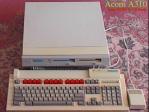
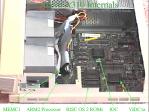
A3xx - the first of the Archimedes range of
computers it was powered by a custom designed chip set based around the ARM
a 32 bit RISC chip. The range started with half a Meg of memory up ran up
to 1 Meg of memory. They came out with the Arthur Operating system that
while it was more advanced than the 8 bit machines OS' it was not an OS
doing justice to the hardware it was running on. Released around late 1987
they heralded the start of new shift in Acorn machines away from their
previous 6502 only base.
A305
512k Memory.
Advanced Disc Filing System by default.
ARM 2 processor.
8 MHz RAM.
512k OS in ROM.
~4 MIPS.
A310
1024k Memory
Advanced Disc Filing System by default.
ARM 2 processor.
8 MHz RAM.
512k OS in ROM.
~4 MIPS.
- A4xx - released at the same time as the 300
series of machines the 400 series features an in built st506 hard drive
controller and some models came equiped with hard drives built in as
standard and the series also, by default, was capable of handling 4
expansion cards including a co-processor card unlike the 300 series.
A410
1024k Memory.
Advanced Disc Filing System by default.
St506 Hard Drive interface by default.
ARM 2 processor.
8 MHz RAM.
512k OS in ROM.
~4 MIPS.
A420
2048k Memory.
Advanced Disc Filing System by default.
St506 Hard Drive interface by default.
ARM 2 processor.
8 MHz RAM.
512k OS in ROM.
~4 MIPS.
A440
4096k Memory.
Advanced Disc Filing System by default.
St506 Hard Drive interface by default with Hard Drive. (43 Meg)
ARM 2 processor.
8 MHz RAM.
512k OS in ROM.
~4 MIPS.
- A680 - development machine for RISCiX. This is
another development machine and again was never sold commercialy, thus it
is somewhat rare. It was different from most Arcs in the respect that it
does not have RiscOS in ROM at all and can only use a high resolution
monochrome monitor for display. It came with a 67 Meg SCSI drive by
default.
8192k Memory.
SCSI by default. (67 Meg drive)
ARM 2 processor.
8 MHz RAM.
Unknown. (Runs RISCiX...)
~4 MIPS.
- M4 - another development machine for RISCiX. This
is an A680 in a large case about 8 times the volume of a standard A400
style Archimedes machine. A very rare beast this one as apparently only two
machines were ever produced. It is rumoured that the first one has been
destroyed, so as far as I am aware there is only one of these machines in
existance.
8192k Memory.
SCSI by default. (Probably a 67 Meg drive)
ARM 2 processor.
8MHZ RAM.
Unknown. (Runs RISCiX...)
~4 MIPS.
- R140 - Acorn's entry machine into the Unix
market, it suffered problems due to the Archimedes chip set not being
optimal for running Unix on. Functionally identical to an A440 machine it
had 4 Meg of memory and was provided with an 52 Meg st506 drive with RISCiX
(Acorns brand of Unix) on it. Due to memory contraints and a large page
size it did not fair terribly well as a Unix workstation. Launched
September 1988.
4096k Memory
Advanced Disc Filing System by default.
St506 Hard Drive interface by default with Hard Drive. (53 Meg)
ARM 2 processor.
8 MHz RAM.
512k OS in ROM. RISCiX OS supplied on Hard Drive.
~4 MIPS.
-
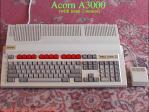
A3000 - this is the low end Arc. It was the first machine to be
released with the newer and faster MEMC1a built in as standard as well as
the newer Risc OS by default. Designed to be a cost effective cheap Arc it
features only one full expansion port with a single internal `mini'
expansion card slot limiting expansion somewhat. It also came by default
without a serial port. This machine has proved very popular with schools as
a cheap entry point into the Archimedes machines. Launched May 1989.
1024k Memory.
Advanced Disc Filing System by default.
ARM 2 processor.
8 MHz RAM.
512k OS in ROM.
~4.7 MIPS.
- A4xx/1 - this series was functionally
identical to the 400 series but featured a newer memory controller the
MEMC1a that gave it a slightly faster speed. It also came with a 53
Megabyte hard drive in the higher end models that came with HD's rather
than the 400 series's 20 Meg one. Launched July 1989. (approximately, these
machines came shortly after the launch of the A3000.)
A410/1
1024k Memory.
Advanced Disc Filing System by default.
St506 Hard Drive interface by default.
ARM 2 processor.
8 MHz RAM.
512k OS in ROM.
~4.7 MIPS.
A420/1
2048k Memory.
Advanced Disc Filing System by default.
St506 Hard Drive interface by default.
ARM 2 processor.
8 MHz RAM.
512k OS in ROM.
~4.7 MIPS.
A440/1
4096k Memory.
Advanced Disc Filing System by default.
St506 Hard Drive interface by default with Hard Drive. (53 Meg)
ARM 2 processor.
8 MHz RAM.
512k OS in ROM.
~4.7 MIPS.
- A540 - This machine comes with 4 Meg of memory
by default and an ARM 3 processor running at 26 MHz. It comes with a 100
Meg SCSI drive by default and a slightly newer version of Risc OS updated
to cope with up to 16 Meg of memory and features for handling the ARM 3
processor. Launched June 1990.
4096k Memory.
Advanced Disc Filing System by default.
SCSI Hard Drive interface by default with Hard Drive. (100 Meg)
ARM 3 processor. (26 MHz)
12 MHz RAM.
512k OS in ROM.
~13.5 MIPS (I am guessing here...)
- R260 - functionally identical to the A540 the
R260 comes with Unix (well RISCiX ) by default and due to the increased
power of the hardware runs it much better. Launched June 1990.
8192k Memory.
Advanced Disc Filing System by default.
SCSI Hard Drive interface by default with Hard Drive. (100 Meg)
ARM 3 processor. (26 MHz)
12 MHz RAM.
512k OS in ROM. RISCiX OS supplied on Hard Drive.
~13.5 MIPS.
- R225 - A diskless version of the R260 it was
designed to be a cheap networked Unix station. Released at the same time as
the R260.
4096k Memory.
Advanced Disc Filing System by default.
ARM 3 processor. (26 MHz)
12 MHz RAM.
512k OS in ROM. RISCiX OS booted off from Network connections.
~13.5 MIPS.
- A5000 - the A5000 is the first machine to
feature high density (quad - 1.6 Meg formated) drives by default as well as
the latest (at the time) version of Risc OS - version 3. It also features
an inbuilt IDE hard drive (40 Meg) on it's higher end model. With the
re-release of the series the basic hard drive size has been upgraded to 80
Meg.
Released September 1991.
1024k Memory.
Advanced Disc Filing System by default with High Density drives.
IDE interface by default.
ARM 3 processor. (25 MHz)
12 MHz RAM.
2048k OS in ROM.
~13.5 MIPS.
- A4 - Acorns first portable machine. The A4 is
functionally an A5000 in portable form. Featuring power save modes, an LCD
screen and software configuration of the power saving features it was
released July 1992. It is called the A4 because it's footprint on a desk is
apparently that of an A4 piece of paper. It is interesting to note that the
A4 is not an A5000 squeezed into portable form but rather the
A5000 is the A4 in desktop form, whereby the A5000 design was largely a
spin off from the design of the A4.
2048k Memory.
Advanced Disc Filing System by default with High Density drives.
ARM 3 processor. (24 MHz normally, 6 MHz in power save mode.)
12 MHz RAM. (3 MHz in power save mode.)
2048k OS in ROM.
~13.25 MIPS.
- A30x0 - Two models of this machine exist the
A3010 and the A3020. Both are designed as low end 'family solution'
machines. They are also among the first machines to feature the ARM250
processor offering improved performance over an ARM2 (but less than an
ARM3) and are designed to supplement the A3000 machine as a low cost entry
machine into the Acorn world. Its other main claim to fame is it is the
first Archimedes series machine that features joystick ports (only in 3010
model, the 3020 has a network connector instead.). Early models of these
machines didn't have an ARM250 in them at all, but rather a daughterboard
card that featured an ARM2, IOC, MEMC and VIDC combined to give the
equivalent of an ARM250. This was due to supply problems with the ARM250
chip and was discontinued once supplies of the processor became stable.
Launched August 27th 1992.
1024k Memory.
Advanced Disc Filing System by default with High Density drives.
IDE 60 Mb Hard Drive (only in A3020 with HD option).
ARM 250 processor.
12 MHz RAM.
2048k OS in ROM.
~7.2 MIPS.
- A4000 - This is a higher end more expandable
version of the 30x0 series machines and is in a three box format similar to
the A5000. It also is driven by an ARM 250 processor however it features
over the A30x0 machines optional Ethernet & Econet ports and an 80Mb IDE
drive by default. The aim of this machine is strongly towards the home
office and more 'serious' applications than the A300x0 series.
Launched August 27th 1992.
2048k Memory.
Advanced Disc Filing System by default with High Density drives.
IDE 80 Mb Hard Drive by default.
ARM 250 processor.
12 MHz RAM.
2048k OS in ROM.
~7.2 MIPS.
- A5000 (alpha variant) - This is an
improved variant on the A5000 featuring a considerably faster processor, 33
MHz, with the ability to have a similarly clocked FPA unit installed. It
also features a considerably larger base hard drive size of 160 Mb on the 4
Mb model, the lower 2 Mb model still as an 80 Mb drive. Finally it has
improved alterations to it allowing easy expansion of the machine to 8 Mb
of memory by default.
Released 10th September 1993.
2048k Memory.
Advanced Disc Filing System by default with High Density drives.
IDE interface by default.
ARM 3 processor. (33 MHz)
12 MHz RAM.
2048k OS in ROM.
~16.96 MIPS.
This is the next generation and architecture of machines - superceeding,
but compatible with, the Archimedes range of machines. All of them feature a
highly configurable and modular system that makes a bewildering variety of
options available. All are founded on the 'second generation' chipset
featuring VIDC20, IOMD and the newer ARM6, and better, cell processors. This
new range was launched on the 15th of April 1994 with the RiscPC 600 series of
machines.
The new machines feature the processor card option, the concept of which
was first shown in the A540 as well as a unique second processor slot allowing
the machines to have two processors in the system, at once, of radically
different types. Simply by slipping a 486 chip in, on an appropriate board of
course, Intel based software can be run on the machine adjacent to native ARM
programs. Both processors share the system resources and can be allocated
memory and the like to use. Memory managment has been improved with memory
paging always being done in 4K pages.
Further more the podule interface has been extended with DMA to and from
podules, extended addressing, 32bit data pathways from the IO system as well
as a vastly expanded memory map for each podule. Realtime video from the IO
system becomes a reality with high speed and data tranfer applications being
boosted considerably. These machines are to be the ones to carry Acorn for the
next three to six years and look set to do so nicely.
- Risc PC 600 series The initial set of machines
that launched the RiscPC range. Initially they all featured 30 MHz
processors, but as of the launch of the Risc PC 700 the 600 series machines
all feature a 33 MHz ARM 610 instead. As of the start of 1996 the base
model of the RiscPC 600 was a 4Mb DRAM machine with a 425 Mb hard drive.
RiscPC 600 2M HD210
2048Kb Memory. (No VRAM)
Advanced Disc Filing System by default with a High Density drive.
IDE interface by default. (210 Mb.)
ARM 610 processor. (33 MHz)
16 MHz RAM.
2048k OS in ROM.
~26 MIPS (Arbitrary estimate.)
RiscPC 600 5M HD210
4096Kb Memory. (1Mb of VRAM)
Advanced Disc Filing System by default with a High Density drive.
IDE interface by default. (210 Mb.)
ARM 610 processor (33 MHz)
16 MHz RAM.
2048k OS in ROM.
~26 MIPS (Arbitrary estimate.)
RiscPC 600 9M HD420
8192Kb Memory. (1Mb of VRAM)
Advanced Disc Filing System by default with a High Density drive.
IDE interface by default. (420 Mb.)
ARM 610 processor (33 MHz)
16 MHz RAM.
2048k OS in ROM.
~26 MIPS (Arbitrary estimate.)
-
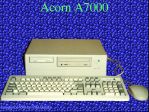
A7000 - a successor to the A4000 machine, this
is a 'cut down' Risc PC intended for school/home entry as a cheaper
alternative to the RiscPC. Both this and the RiscPC 700 are the first
machines to feature RISC OS 3.6. Unlike the RiscPC the A7000 has no second
processor slot, only one DRAM socket and no VRAM capabilities. This limits
the memory expansion of the machine to 128Mb + whatever memory is soldered
on the motherboard.
Launched 12th of July 1995
A7000 Net
2048Kb Memory.
Advanced Disc Filing System by default with a High Density drive.
Ethernet interface in place of hard drive.
ARM7500 processor. (32 MHz)
16 MHz RAM.
4096k OS in ROM.
~25 MIPS (Arbitrary estimate.)
A7000 (Base Configuration)
2048Kb Memory.
Advanced Disc Filing System by default with a High Density drive.
IDE interface by default. (425 Mb.)
ARM7500 processor. (32 MHz)
16 MHz RAM.
4096k OS in ROM.
~25 MIPS (Arbitrary estimate.)
A7000 (expanded specification)
4096Kb Memory.
Advanced Disc Filing System by default with a High Density drive.
IDE interface by default. (425 Mb.)
ARM7500 processor. (32 MHz)
16 MHz RAM.
4096k OS in ROM.
~25 MIPS (Arbitrary estimate.)
- Risc PC 700 series is the second generation of
Risc PCs to be shipped. They feature the newer ARM710 processor, 16 bit
sound as default with audio mixer on the motherboard and RISC OS 3.6. Not
so much a major advancement as an incremental improvement of the RiscPC to
keep pace with the computing world.
Launched 12th of July 1995.
RiscPC 700 4M HD425
4096Kb Memory.
Advanced Disc Filing System by default with a High Density drive.
IDE interface by default. (425 Mb.)
ARM710 processor. (40 MHz)
16 MHz RAM.
4096k OS in ROM.
~32 MIPS (Arbitrary estimate.)
RiscPC 700 5M HD425
4096Kb Memory. (1 Mb of VRAM)
Advanced Disc Filing System by default with a High Density drive.
IDE interface by default. (425 Mb.)
ARM710 processor. (40 MHz)
16 MHz RAM.
4096k OS in ROM.
~32 MIPS (Arbitrary estimate.)
RiscPC 700 10M HD850
8192Kb Memory. (2 Mb of VRAM)
Advanced Disc Filing System by default with a High Density drive.
IDE interface by default. (850 Mb.)
ARM710 processor. (40 MHz)
16 MHz RAM.
4096k OS in ROM.
~32 MIPS (Arbitrary estimate.)
Acorn, around October 1995, restructured itself into seperate companies.
Consequently the originating company will be noted by the machine model name,
in brackets, from here on down.
As part of an image strengthening procedure Acorn have kept their
internal structure of seperate companies but now all of them market under
the Acorn name. Consequently I won't be marking which subdivision 'makes'
the machine anymore.







